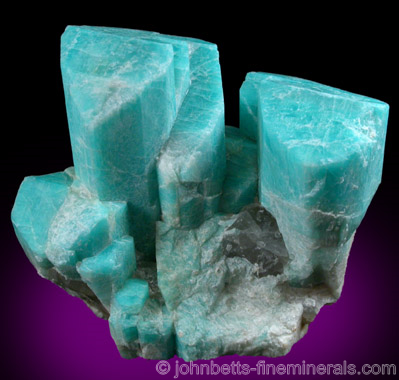The Mineral microcline

Microcline is polymorphous with Orthoclase and Sanidine. These three minerals form the Potassium Feldspar group. They are almost identical in physical properties, and sometimes it is impossible to distinguish one another without x-ray analysis. The only difference between them is their crystal structure. Microcline crystallizes in the triclinic system, and Orthoclase and Sanidine crystallize in the monoclinic system. Crystals of Microcline are generally much larger than those of
Orthoclase, and a deep green color is tell-tale sign of Microcline, since
Orthoclase does not exist in a deep green color.
In some mineral reference guides, Microcline and Sanidine are wrongly
categorized as variety of Orthoclase. Since it is so difficult to
distinguish between Orthoclase, Sanidine, and Microcline, they may be
simply called "Potassium Feldspar".
Microcline sometimes forms in association with Albite or other Plagioclase feldspar in alternating patterns, and forms a feldspar rock known as Perthite.
Chemical Formula
KAlSi3O8
Color
White, cream, light yellow, light brown, reddish-brown, pink, light blue, blue-green, green, deep green. Sometimes multicolored with alternating green and white color. May also exhibit a color sheen known as adularescence.
Properties
Streak
White |
Hardness
6 |
Transparency
Translucent to opaque |
Specific Gravity
2.5 - 2.6 |
Luster
Vitreous |
Cleavage
2,1 - basal ; 2,1 - prismatic ; 3,1 - pinacoidal. The cleavage angle is about 90º. |
Fracture
Conchoidal to uneven |
Tenacity
Brittle |
Crystal Habits
Most often in well formed crystals, which may be enormous in size. The crystals of Microcline are very similar to those of Orthoclase, and form the same twinning habits. Also in grainy and in compact crystal aggregates.
Click here
for more detailed information on the crystal structure of the
Feldspars.
Varieties
-
Deep green or greenish-blue variety of Microcline. Also called Amazonstone or Amazon Stone.
See the gemstone section on Amazonite for more information.
Uses
Microcline is industrially important in the manufacture of glass and
ceramics.Well shaped crystals, especially those of Amazonite are cherished by mineral collectors. Amazonite is also used as a gemstone, and is polished into beads, cabochons, and ornamental figures.
Also see the gemstone section on Amazonite.
Noteworthy Localities
Microcline is an extremely common mineral, and only remarkable occurrences are mentioned here. Excellent crystals associated with Aegirine come from Mount Malosa, Malawi. Other worldwide sources of large Microcline crystals are the Erongo Mountains, Namibia; Papachacra, Catamarca, Argentina; the Shigar Valley, Skardu, Pakistan. Famous twin come from Lake Maggiore, Baveno, Italy.
Large crystals once came from Bedford, Westchester Co., New York; Leiper's Quarry, Delaware Co., Pennsylvania; the Poor House Quarry, West Bradford, Chester Co., Pennsylvania; Middletown, Middlesex Co., Connecticut; and Moat Mountain, Carroll County, New Hampshire. White to light pink Microcline has come from the French Creek area, Chester Co., Pennsylvania. Well formed crystals are widespread at Mont Saint Hilaire, Quebec, Canada.
The variety Amazonite provides many outstanding localities. Deep green Amazonite has come from Parusnaya Mountain, Kola Peninsula, Russia; Santa Maria de Itabira, Minas Gerais, Brazil; Mogok, Burma (Myanmar); and Kenticha and Konso, Sidamo-Borana Province, Ethiopia.
Some of the finest material is from the Pikes Peak area in Colorado. This region encompasses a large area in El Paso, Teller, Douglas, and Park counties. Particularly exceptional deposits in this area include Pikes Peak, Crystal Peak, Devils Head, Lake George, and Florissant. Although some of the deposits are quite distant from each other, all material from this area may be referred to as "Pikes Peak Amazonite", as all the material from this area is almost identical.
Other U.S. occurrences of Amazonite are Amelia Court House, Amelia Co., Virginia; the Zapot pegmatite, Mineral Co., Nevada; Fairfield, Utah Co., Utah; Valhalla, Westchester Co., New York; and Franklin, Sussex Co., New Jersey.
The Sunstone form of Microcline comes Oregon at the Dust Devil Mine, Plush, Lake Co., and from the Ponderosa Sunstones Mine, Harney Co., where it has Copper inclusions.
Common Mineral Associations
Quartz (especially Smoky Quartz), Muscovite, Plagioclase Feldspars
Distingushing Similar Minerals
Orthoclase - Indistinguishable without complex methods. However, Microcline can have a deep green color that Orthoclase cannot achieve.
Sanidine - Indistinguishable without complex methods. Sanidine, however, is never opaque.
Plagioclase Feldspar - May exhibit striations on twinned crystal surfaces, otherwise difficult to distinguish.
Spodumene - Has a splintery fracture.
Calcite - Much lower hardness.